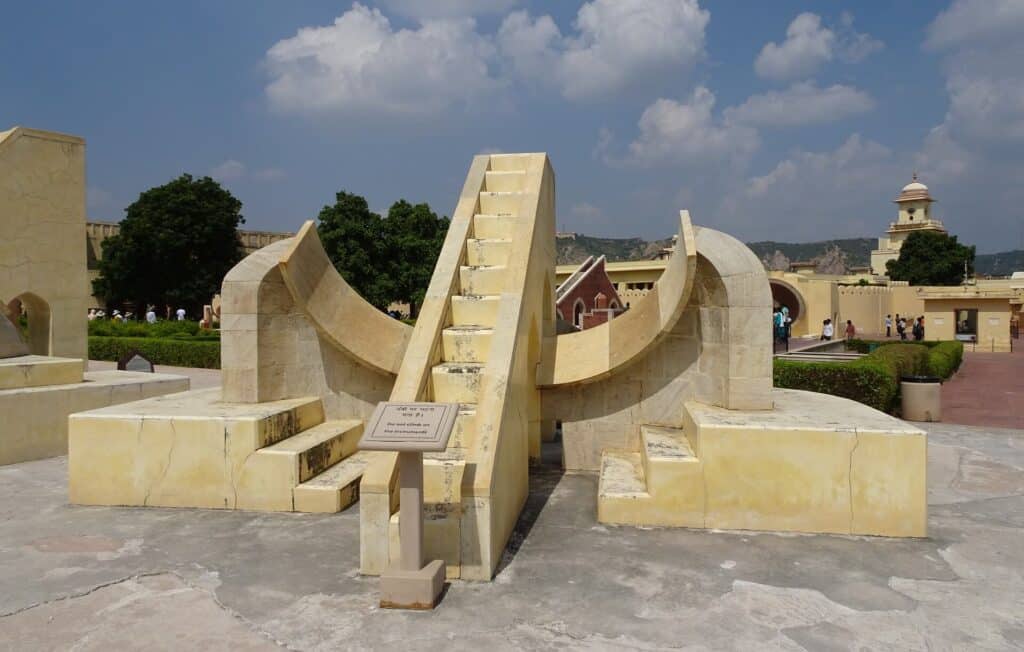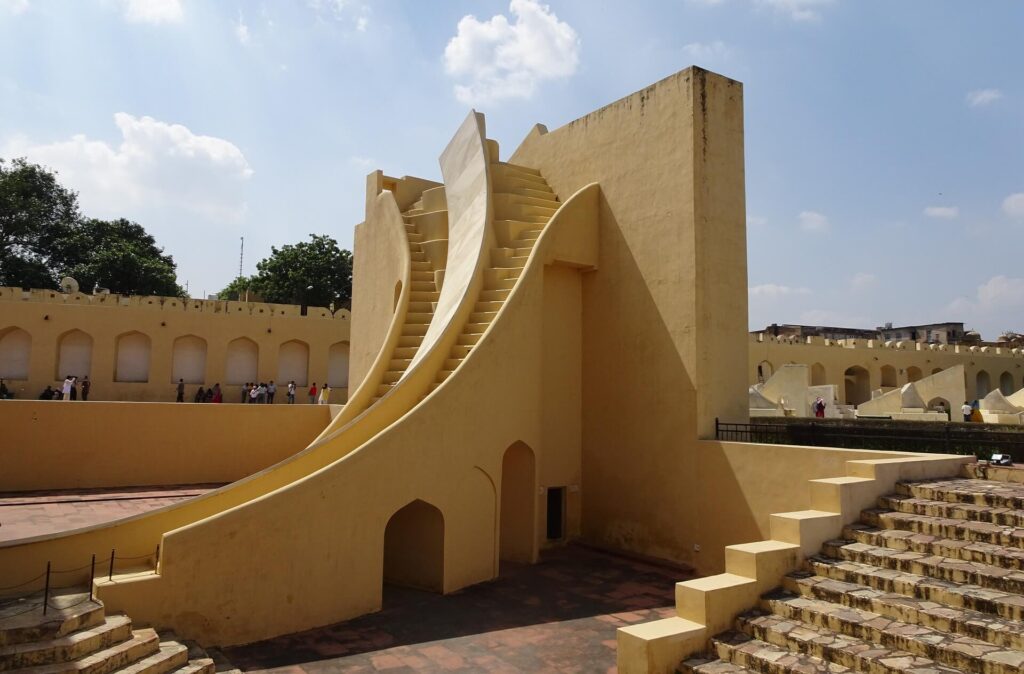Nestled in the heart of the Pink City, Jaipur, the Jantar Mantar is a fascinating astronomical observatory that has stood the test of time for centuries. It is a testament to India’s rich history of scientific achievement and architectural marvels. Jantar Mantar, which translates to “calculation instrument” in Sanskrit, is a collection of 19 architectural instruments built by Maharaja Jai Singh II in the early 18th century.
Jantar Mantar Jaipur: A Living Heritage of Astronomy
Jantar Mantar was constructed with the primary purpose of accurately measuring time, predicting eclipses, and tracking celestial objects. The observatory is a fine example of India’s age-old tradition of scientific inquiry and astronomy.
Its significance goes beyond the architectural beauty that graces Jaipur’s skyline, as it represents the incredible astronomical knowledge of ancient India.

History of Jantar Mantar Jaipur
The history of Jantar Mantar is a captivating journey that takes us back to the early 18th century, to the reign of Maharaja Jai Singh II of Jaipur. This visionary ruler had a deep interest in astronomy and a profound understanding of the importance of accurate celestial observations for various aspects of life, including agriculture, astrology, and timekeeping.
- Maharaja Jai Singh II: The Visionary Behind Jantar Mantar
Maharaja Jai Singh II, who ascended the throne in 1699, was not only a formidable military leader but also a polymath with a keen interest in science and mathematics. Recognizing the limitations of the existing astronomical instruments of his time, he embarked on an ambitious project to create a state-of-the-art observatory that would outshine all others.
- The Birth of Jantar Mantar
In 1724, construction began on what would become the Jantar Mantar observatory in Jaipur. Maharaja Jai Singh II appointed a team of skilled astronomers, mathematicians, and architects to assist him in realizing his vision. The site chosen for this grand undertaking was strategically located in the heart of Jaipur, within the city walls.
- Architectural Marvel
Over a period of several years, the various instruments that make up Jantar Mantar were meticulously designed and constructed. Maharaja Jai Singh II personally oversaw the project to ensure its precision and accuracy. The observatory was designed to be a comprehensive collection of instruments, each serving a specific astronomical purpose.
- Astronomy Meets Architecture
Jai Singh’s vision married the realms of science and art, resulting in the creation of architectural marvels that continue to astound visitors to this day. The observatory’s instruments are not only accurate in their astronomical observations but also striking in their design, blending aesthetics with functionality.
- A UNESCO World Heritage Site
In 2010, Jantar Mantar was rightfully recognized by UNESCO as a World Heritage Site, solidifying its place as a cultural treasure of global significance. Today, it stands as a living testament to India’s scientific prowess and architectural ingenuity.
Jaipur Jantar Mantar Ticket Price 2023
Here’s the ticket price information for Jantar Mantar Jaipur in tabular form:
| Category | Ticket Price (in INR) |
| Indian Adults | 52 |
| Indian Students | 25 |
| Foreign Adults | 200 |
| Foreign Students | 100 |
Timings of Jantar Mantar Jaipur 2023
Here’s the timing information for Jantar Mantar Jaipur for all days of the week:
| Day of the Week | Opening Time | Closing Time |
| Monday | 9:00 AM | 4:30 PM |
| Tuesday | 9:00 AM | 4:30 PM |
| Wednesday | 9:00 AM | 4:30 PM |
| Thursday | 9:00 AM | 4:30 PM |
| Friday | 9:00 AM | 4:30 PM |
| Saturday | 9:00 AM | 4:30 PM |
| Sunday | 9:00 AM | 4:30 PM |
Inside Jantar Mantar (Attractions & Instruments)
The Jantar Mantar observatory in Jaipur is home to a fascinating array of astronomical instruments, each with its unique purpose and significance.

Here are some of the key attractions you can explore inside Jantar Mantar:
1. Samrat Yantra (Supreme Instrument):
The Samrat Yantra is the largest sundial in the world, standing at a towering 27 meters (89 feet) in height. It accurately measures time with an impressive precision of 2 seconds. The shadow it casts allows visitors to determine the local time with remarkable accuracy.
2. Jai Prakash Yantra:
This instrument consists of two hemispherical bowls with markings for measuring the position of celestial objects such as the sun, moon, and stars. It was used to determine the local and meridian altitudes of celestial bodies.
3. Ram Yantra:
This massive instrument is a circular structure with two large cylindrical pillars. It was used for measuring the altitude of celestial objects and helped astronomers calculate the altitude of celestial bodies as they crossed the meridian.
4. Digamsha Yantra:
This instrument is designed to measure the azimuth (horizontal direction) of celestial bodies. It resembles a large, graduated protractor and is used to determine the exact direction of various celestial objects.
5. Narivalaya Yantra:
Also known as the Equatorial Sundial, this instrument is used to measure the time of day and the declination of celestial objects. It consists of two parallel discs with graduated markings.
6. Kranti Yantra:
The Kranti Yantra is a set of two cylindrical instruments used for measuring the longitude and latitude of celestial objects. These instruments were crucial for navigation and determining the positions of celestial bodies accurately.
7. Chakra Yantra:
This unique instrument resembles a circular, segmented sundial. It was used for calculating the position of celestial objects, including the time and direction of their rising and setting.
8. Dhruva Darshak Pattika:
This small, circular structure with an aperture in its center was used to locate the pole star, Dhruva, which was essential for celestial navigation.
9. Yantra Raj:
Yantra Raj is a central platform within the observatory where many of the instruments are located. It provides a panoramic view of the entire complex and is an ideal spot to observe the various instruments and understand their functions.
10. Astronomical Exhibits:
In addition to the historic instruments, Jantar Mantar also features informative exhibits and displays that provide insights into the history of astronomy in India, the life of Maharaja Jai Singh II, and the significance of Jantar Mantar as a UNESCO World Heritage Site.




